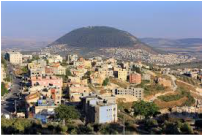
- Karoline Lewis
READING:
About eight days after Jesus said these things, he took Peter, John, and James, and went up on a mountain to pray. As he was praying, the appearance of his face changed and his clothes flashed white like lightning. Two men, Moses and Elijah, were talking with him. They were clothed with heavenly splendor and spoke about Jesus’ departure, which he would achieve in Jerusalem. Peter and those with him were almost overcome by sleep, but they managed to stay awake and saw his glory as well as the two men with him. As the two men were about to leave Jesus, Peter said to him, “Master, it’s good that we’re here. We should construct three shrines: one for you, one for Moses, and one for Elijah”—but he didn’t know what he was saying. Peter was still speaking when a cloud overshadowed them. As they entered the cloud, they were overcome with awe. Then a voice from the cloud said, “This is my Son, my chosen one. Listen to him!” Even as the voice spoke, Jesus was found alone. They were speechless and at the time told no one what they had seen. The next day, when Jesus, Peter, John, and James had come down from the mountain, a large crowd met Jesus. A man from the crowd shouted, “Teacher, I beg you to take a look at my son, my only child. Look, a spirit seizes him and, without any warning, he screams. It shakes him and causes him to foam at the mouth. It tortures him and rarely leaves him alone. I begged your disciples to throw it out, but they couldn’t.” Jesus answered, “You faithless and crooked generation, how long will I be with you and put up with you? Bring your son here.” While he was coming, the demon threw him down and shook him violently. Jesus spoke harshly to the unclean spirit, healed the child, and gave him back to his father. Everyone was overwhelmed by God’s greatness.
- Luke 9.28-43 (CEB)
REFLECTION:
More times than not, Luke’s narrative of Jesus’ transfiguration is concluded at verse 36; thus isolating it from the narrative of what happened when Jesus and his entourage descended the mountain and were confronted by pain and suffering. However, many students of Luke, myself included, consider the following passage, verses 37 through 43, as intimately connected to the transfiguration on the mountaintop. This is because it is what happens in the noisy streets, in the thick of life’s fray, that provides a fuller understanding of what transfiguration means.
Sure, the vision on the mountaintop reveals a glimpse of the Christ as Christ has always been, shining like a flaming sun; radiant, brilliant, truly incomprehensible, truly impenetrable mystery. But this was true even when Christ “Manned himself” (as Madeleine L’Engle refers to the incarnation) and divine glory was cloaked by the humanity of Jesus. We have not been graced with a vision like that shared by Peter, John, and James; thus we must seek the meaning of transfiguration in Jesus, and the way he lived his life. That is revealed in the second part of the narrative, which features the compassion of the man Jesus who hailed from Nazareth. As Jesus was fond of saying, let those with ears to hear…
Could it be that the healing of a tortured child is itself a manifestation of God’s glory? And could it be that we too are called to be transfigured by our daily encounter with the Christ, and to go into the noisy streets to heal, comfort, and share Good News? It’s worth thinking about, and that’s what I invite you to do between now and Sunday, when I hope to worship with you at 8:30 or 10: 30.

 RSS Feed
RSS Feed



